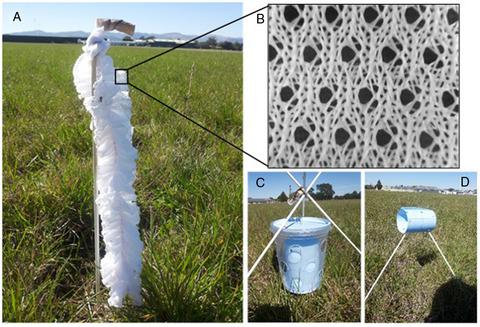当前位置:
X-MOL 学术
›
Entomol. Exp. Appl.
›
论文详情
Our official English website, www.x-mol.net, welcomes your feedback! (Note: you will need to create a separate account there.)
Visually and olfactorily enhanced attractive devices for thrips management
Entomologia Experimentalis et Applicata ( IF 1.9 ) Pub Date : 2020-09-01 , DOI: 10.1111/eea.12969 Robert W. H. M. Tol 1 , Melanie M. Davidson 2 , Ruth C. Butler 2 , David A. J. Teulon 2 , Willem Jan Kogel 1
Entomologia Experimentalis et Applicata ( IF 1.9 ) Pub Date : 2020-09-01 , DOI: 10.1111/eea.12969 Robert W. H. M. Tol 1 , Melanie M. Davidson 2 , Ruth C. Butler 2 , David A. J. Teulon 2 , Willem Jan Kogel 1
Affiliation

|
‘Lure‐and‐infect’ is an insect pest management strategy with high potential but so far there are few examples of its application. Using traps as surrogates for auto‐dissemination devices, we tested the attractiveness to naturally occurring thrips (Thysanoptera: Thripidae) of three trap types differing in colour and structure, with and without the thrips lure methyl isonicotinate (MI), and sticky plate traps as a control. The aim was to find more effective traps that could be further developed into devices for auto‐dissemination and lure‐and‐infect of thrips. The number of thrips captured varied substantially with trap type and the presence of the MI lure. We found a high visual response to a sticky ‘white ruffle’ trap (i.e., a 30‐cm‐long cylindrical outline of folded fabric), compared to a commonly used blue sticky plate trap (Bug‐scan) as the control. This effect was seen both in a greenhouse with roses (Rosa spp.), where we encountered western flower thrips, Frankliniella occidentalis (Pergande), and in a grass field, where we encountered onion thrips, Thrips tabaci Lindeman, and New Zealand flower thrips, Thrips obscuratus (Crawford). In the absence of MI, the white ruffle trap caught 7–22× more thrips than the control Bug‐scan trap. A similarly designed blue ruffle trap and a modified Lynfield trap caught lower thrips numbers than the white ruffle and the control Bug‐scan traps. Presence of MI substantially increased the captures of T. tabaci in all three trap types in the field (2.5–18×). In the greenhouse, without MI the white ruffle trap caught 3.5–14× more thrips than the Bug‐scan, blue ruffle, or modified Lynfield traps. Presence of MI increased the captures of F. occidentalis males and females in the Lynfield and blue ruffle traps (1.4–2.8×), but not in the white ruffle trap in the greenhouse (ca. 1.1×). The importance of visual and olfactory factors for the design of effective auto‐dissemination and lure‐and‐infect strategies for thrips management is discussed.
中文翻译:

用于蓟马管理的视觉和嗅觉增强的有吸引力的设备
“引诱和感染”是一种具有很高潜力的害虫管理策略,但到目前为止,其应用的例子很少。使用陷阱作为自动传播装置的替代物,我们测试了三种不同颜色和结构的陷阱类型对天然存在的蓟马(缨翅目:蓟马科)的吸引力,有和没有蓟马引诱异烟酸甲酯(MI),粘板陷阱作为一个控制。目的是找到更有效的诱捕器,这些诱捕器可以进一步发展成为蓟马自动传播和引诱感染的装置。捕获的蓟马数量随捕集类型和 MI 诱饵的存在而有很大差异。我们发现对粘性“白褶边”陷阱(即折叠织物的 30 厘米长圆柱形轮廓)有很高的视觉反应,与常用的蓝色粘板陷阱(Bug-scan)作为对照相比。这种效果在种植玫瑰(Rosa spp.)的温室中看到,在那里我们遇到了西部花蓟马、Frankliniella occidentalis(Pergande)和在草地上看到了洋葱蓟马、烟蓟马林德曼和新西兰花蓟马, 蓟马 (Crawford)。在没有 MI 的情况下,白色褶皱陷阱捕获的蓟马比对照 Bug-scan 陷阱多 7-22 倍。设计类似的蓝色褶皱陷阱和改良的 Lynfield 陷阱捕获的蓟马数量低于白色褶皱陷阱和对照 Bug-scan 陷阱。MI 的存在大大增加了田间所有三种陷阱类型中烟粉虱的捕获量(2.5-18 倍)。在温室中,在没有 MI 的情况下,白色褶边陷阱捕获的蓟马比 Bug-scan、蓝色褶边陷阱多 3.5-14 倍,或改良的林菲尔德陷阱。MI 的存在增加了 Lynfield 和 blue ruffle 陷阱中 F. occidentalis 雄性和雌性的捕获量(1.4-2.8×),但在温室中的白色皱褶陷阱中没有增加(约 1.1×)。讨论了视觉和嗅觉因素对于设计有效的蓟马管理的自动传播和引诱感染策略的重要性。
更新日期:2020-09-01
中文翻译:

用于蓟马管理的视觉和嗅觉增强的有吸引力的设备
“引诱和感染”是一种具有很高潜力的害虫管理策略,但到目前为止,其应用的例子很少。使用陷阱作为自动传播装置的替代物,我们测试了三种不同颜色和结构的陷阱类型对天然存在的蓟马(缨翅目:蓟马科)的吸引力,有和没有蓟马引诱异烟酸甲酯(MI),粘板陷阱作为一个控制。目的是找到更有效的诱捕器,这些诱捕器可以进一步发展成为蓟马自动传播和引诱感染的装置。捕获的蓟马数量随捕集类型和 MI 诱饵的存在而有很大差异。我们发现对粘性“白褶边”陷阱(即折叠织物的 30 厘米长圆柱形轮廓)有很高的视觉反应,与常用的蓝色粘板陷阱(Bug-scan)作为对照相比。这种效果在种植玫瑰(Rosa spp.)的温室中看到,在那里我们遇到了西部花蓟马、Frankliniella occidentalis(Pergande)和在草地上看到了洋葱蓟马、烟蓟马林德曼和新西兰花蓟马, 蓟马 (Crawford)。在没有 MI 的情况下,白色褶皱陷阱捕获的蓟马比对照 Bug-scan 陷阱多 7-22 倍。设计类似的蓝色褶皱陷阱和改良的 Lynfield 陷阱捕获的蓟马数量低于白色褶皱陷阱和对照 Bug-scan 陷阱。MI 的存在大大增加了田间所有三种陷阱类型中烟粉虱的捕获量(2.5-18 倍)。在温室中,在没有 MI 的情况下,白色褶边陷阱捕获的蓟马比 Bug-scan、蓝色褶边陷阱多 3.5-14 倍,或改良的林菲尔德陷阱。MI 的存在增加了 Lynfield 和 blue ruffle 陷阱中 F. occidentalis 雄性和雌性的捕获量(1.4-2.8×),但在温室中的白色皱褶陷阱中没有增加(约 1.1×)。讨论了视觉和嗅觉因素对于设计有效的蓟马管理的自动传播和引诱感染策略的重要性。


























 京公网安备 11010802027423号
京公网安备 11010802027423号